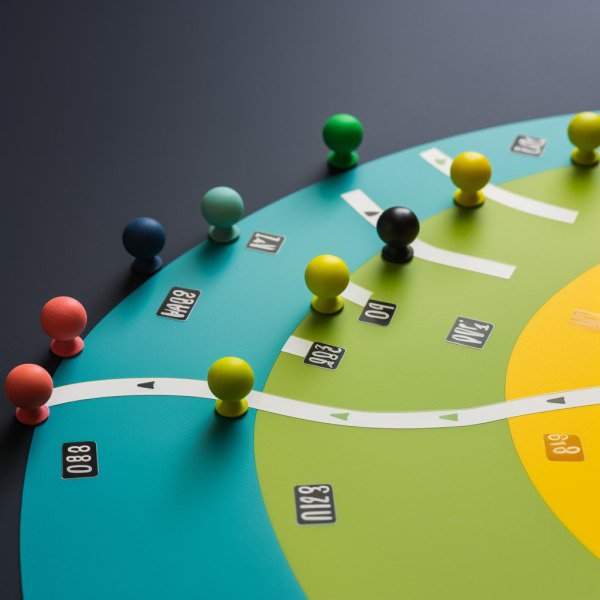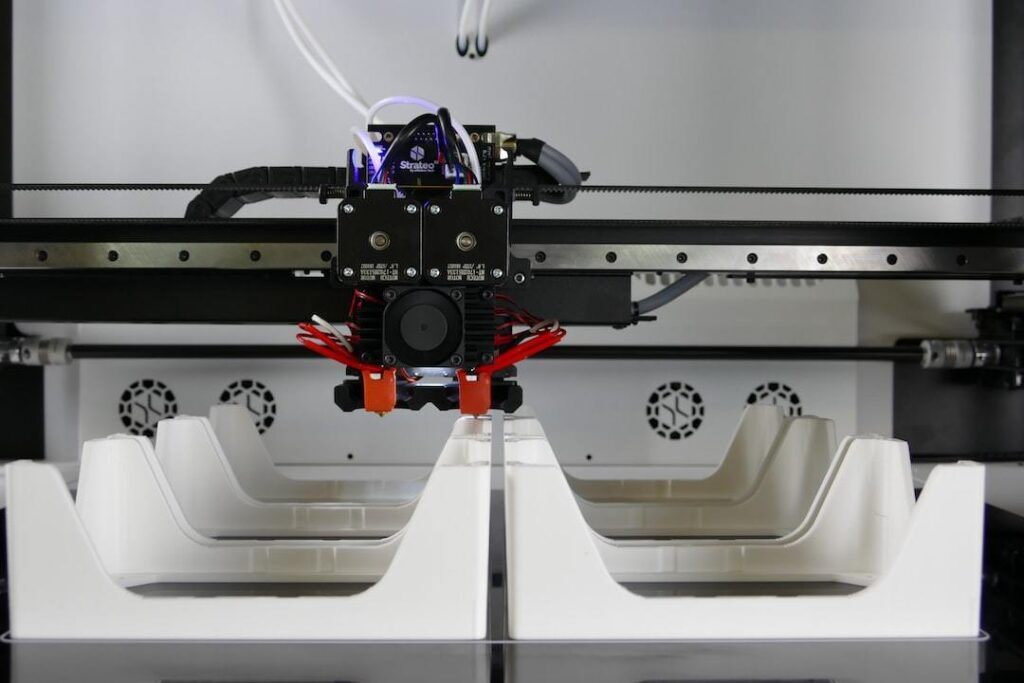Have you ever looked at a product and thought, “I could make a product” like this but even better? If so, let me tell you – it’s not just wishful thinking. With the right tools and knowledge, anyone can turn an idea into reality.
Navigating Making a Product: A Comprehensive Guide
I’ve seen small business owners transform their garage-born ideas into products that solve real problems for people. The process is never easy – it involves countless hours of brainstorming, refining concepts, protecting intellectual property rights, nailing down the production process…the list goes on.
Is all this hard work worth the effort? But when your final product hits shelves (physical or digital), when customers buy because your solution makes their lives easier – there’s no feeling quite like that.
Got your interest? Stick around, we’re about to dive deep into navigating these.
Table of Contents:
- Understanding the Product Development Process
- The Role of a Development Team in Product Creation
- Finding Your Lean Production Methodology
- Identifying Your Target Market
- Potential Partners in Reaching Your Target Market
- Conducting Market Research and Competitive Analysis
- Finding Your Marketing Plan’s North Star
- Nailing Down Your Unique Selling Points With Competitive Analysis
- Pitfalls To Avoid When Conducting Market Research
- Generating Product Ideas and Brainstorming
- Solve Real Problems With Your Product
- Leveraging First-hand Experience
- Incorporating Market Trends and Customer Feedback
- Protecting Your Intellectual Property
- The Role of Non-Disclosure Agreements
- Making Sense Out Of NDAs
- Designing Your Product
- The Power of Prototyping
Finding The Balance Between Design And Functionality - The Role of Product Size
- Creating a Marketing Plan
- Understanding Your Target Audience
- Crafting Engaging Content
- Selecting Effective Channels for Promotion
- Maintaining Consistency in Your Marketing Efforts
- Establishing a Supply Chain and Production Partners
- Production Process: Don’t Ignore the Details
- Picking Your Production Partners: Not All Heroes Wear Capes
- The Supply Chain: Your Roadmap to Success
- Pricing and Profit Margin
- Finding Your Pricing Sweet Spot
- Balancing Act: Cost vs Value
- Profit Margin Matters
- Launching and Selling Your Product
- Selling Online: The New Norm
- Distribution Channels & Order Quantity Considerations
- Sales Process: An Integral Part of Your Launch Strategy
- FAQs in Relation to Make a Product
- How do you create your own product?
- How do I create my own product to sell?
- What are the 7 steps to create a new product?
- How can I come up with a product?
- Conclusion
Understanding the Product Development Process
Making a product that truly resonates with your target audience is not just about having a good idea. It’s more than that; it involves an intricate process known as product development. This journey from concept to creation has several key steps, each playing a vital role in transforming an abstract thought into something tangible and market-ready.

The Role of a Development Team in Product Creation
A successful product starts with an innovative idea, but how do you bring this vision to life? That’s where your product development team comes in. They are the ones who transform ideas into reality using their technical expertise and creativity.
In many ways, they’re like architects: Just as building designers plan structures down to the last brick before construction begins, your team must outline every detail of your proposed item – size, materials used, functionalities offered – even before actual production kicks off.
This detailed planning can help avoid wasting time and resources – important commodities for any small business owner. According to industry insights, businesses waste $97 million for every $1 billion invested due to poor project performance. By having a well-thought-out product development plan, you reduce risk and ensure efficient use of funds right from day one.
The next step after planning is developing a prototype or sample product based on this blueprint — another area where these experts shine. The creation phase tests if our plans work in practice while allowing us space for tweaks until we’re happy with what we have.
Finding Your Lean Production Methodology
If there was ever proof that ‘less is more’, it would be lean production methodology—a strategy aimed at reducing waste while ensuring quality. This method focuses on eliminating any steps that do not add value to the final product, thus creating a streamlined development process.
And it’s not just about cost-cutting: Going lean helps you deliver your products faster and meet customer expectations more effectively. Toyota have incorporated this into their approach to production, making it an essential part of how they work.
Means fine-tuning your strategies, boosting efficiency, or refining customer service. The key is to always be on the lookout for ways to do things better—because even small changes can lead to big results over time.
Key Thought:
Creating a product is an intricate journey, transforming ideas into reality with the help of your development team. They meticulously plan every detail to avoid wasted time and resources. Utilizing lean production methodology reduces waste and improves quality by eliminating non-value adding steps in the process. Always seek improvements – even small changes can yield big results.
Identifying Your Target Market
Figuring out who’s gonna purchase your product is the initial move to take. This isn’t just about knowing their age or location, but digging deeper into their needs, desires, and habits.
Your target market can be more than one group of people. But for each product you create, there should be a specific audience in mind. For instance, if you are developing an eco-friendly water bottle, the intended demographic may be people who prioritize sustainability when making purchases.
Potential Partners in Reaching Your Target Market
Finding potential partners who already have access to your target market can save time and resources while expanding reach. They may include influencers within the community or businesses that complement yours without competing directly against it.
For instance, partnering with fitness bloggers could give your eco-friendly water bottles exposure among health-conscious individuals keen on sustainability – they’re both part of the larger ‘wellness’ trend after all. Collaborating with these influencers not only boosts visibility but also enhances credibility as recommendations come from trusted sources within the consumer product sphere.
Involving such strategic partnerships early in your business journey helps ensure success when reaching out to potential customers and establishing a foothold within desired markets. Shopify offers insightful tips on how best to approach this aspect of marketing strategy development.
Conducting Market Research and Competitive Analysis
Before embarking on the product design journey, it is essential to be aware of the current market and competitive landscape. And by that, we mean understanding your market and competition. Think of this as a reconnaissance mission in the world of business warfare.
The goal is simple: get insights about what’s already out there so you can make sure your product stands out from the crowd. But how do we do this? Glad you asked.
Finding Your Marketing Plan’s North Star
A marketing plan, much like a treasure map, needs a north star – something to guide its path towards success. That ‘north star’ comes from understanding both your potential customers’ desires and competitors’ offerings.
Interacting with individuals who are probably going to purchase your item (known as your intended interest group) can give profitable understanding into their necessities, inclinations, and buying propensities.
Nailing Down Your Unique Selling Points With Competitive Analysis
Competitive analysis isn’t just for big corporations or tech startups; even small businesses benefit hugely from knowing their competition inside-out. It helps tailor brainstorming sessions around unique selling points which give them an edge over others in the same space.
- Spy on Competitors: Look at what they’re doing well – but more importantly where they’re dropping the ball.
- Analyze Their Strategy: This could be anything from pricing strategies or sales channels all down to social media presence.
- Create Superior Products: The aim here isn’t necessarily inventing something entirely new; sometimes it means making existing products better based on real customer feedback.
By conducting a competitive analysis, you’re not just getting to know your competitors better but also gaining insights into the product market. Identifying a unique area of focus can assist in distinguishing yourself from the competition.
Pitfalls To Avoid When Conducting Market Research
The process of gathering data about markets and customers is crucial for effective decision making in business. However, it’s important to avoid certain pitfalls that could jeopardize this process:
- Keeping our attention on the task at hand
Key Thought:
Understanding your market and competition is key before you start designing a product. This means conducting research to understand potential customers’ needs and preferences, analyzing competitors’ strategies, identifying their weaknesses, and improving on existing products based on real customer feedback. Avoid pitfalls in the process for effective decision-making.
Generating Product Ideas and Brainstorming
The first step in developing a successful product is to uncover the right concept. But how do you get that? You start by identifying real problems that need solutions. For instance, think about daily life inconveniences or industry-specific issues.
A good place to begin your brainstorming session is in conversation with others – family, friends, colleagues. The most effective products often stem from personal frustrations and needs.
You may also want to evaluate existing products on the market, questioning if they can be enhanced or if there is something absent in their performance. Can they be improved? Is there something missing in their functionality? Gaining comprehension into potential areas of progress can be achieved by addressing these queries.

Solve Real Problems With Your Product
While thinking of an innovative product idea might seem like hitting the jackpot, it’s crucial not just to create something new but rather solve real problems effectively. Innovative ideas are born when we focus on making lives easier or better with our products.
To find these problem-solving opportunities, try immersing yourself in various situations — this could mean different cultures, environments or even industries than your own. By expanding your horizons beyond familiar territories you’ll encounter fresh perspectives which may spark novel ideas.
Leveraging First-hand Experience
Your firsthand experiences provide valuable insight into what works and what doesn’t—use them. Have you ever encountered a tool that didn’t quite work as well as it should have? Or perhaps wished for a service that wasn’t available?
This perspective makes us all capable inventors because we understand our pain points better than anyone else does. Turning these pain points into product ideas can lead to creations that resonate with consumers who’ve experienced similar frustrations.
Incorporating Market Trends and Customer Feedback
Another effective method of generating product ideas is staying up-to-date with market trends. Observing popular themes in your industry or niche helps you predict what customers might want next, giving you a competitive edge. Predicting market trends is an art worth mastering.
Don’t just watch, get out there and ask for customer feedback. You’ll find straight-up insights into what folks want from products like yours. Use this goldmine of information in your brainstorming sessions. By utilizing the data obtained from products similar to yours, you can ensure that your product is providing customers with what they need.
Key Thought:
feedback. Being in tune with your audience’s needs and wants is crucial. Understand their pain points, then work to develop products that address these issues directly. This way, you’ll be creating solutions that are not just innovative but also genuinely helpful and marketable. Keep a pulse on industry trends to ensure your product stays relevant and competitive.
Protecting Your Intellectual Property
When devising a top-notch product, it is essential to safeguard your exclusive concepts in addition to addressing genuine issues. When you pour time and creativity into developing something new, protecting your intellectual property becomes crucial.
You might ask, why is this so important? Well, imagine if after all the effort of designing an innovative solution to solve real problems in the market, someone else takes credit for your work. It’s like baking a delicious cake only for someone else to put their name on it and sell it.
A Non-disclosure Agreement (NDA) is an invaluable tool for protecting your innovative product from being taken credit for by someone else. NDAs can be likened to secret-keeping contracts between you and anyone who comes into contact with your product before its launch. They’re kind of like those pinky promises we made as kids – but with legal implications.
The Role of Non-Disclosure Agreements
A non-disclosure agreement, often referred to as an NDA or confidentiality agreement, is a legally binding contract that outlines information shared between parties but restricted from wider use or disclosure.
In terms of products creation process, think of an NDA as invisible fencing around sensitive details regarding what makes your product tick – perhaps its unique design elements or proprietary software code. The fence helps keep these precious details within designated boundaries until you’re ready for the big reveal at product launch.
Making Sense Out Of NDAs
When dealing with potential partners during early stages of development or manufacturing processes involving production partners , using an NDA provides a safety net against unwanted leaks that could compromise first-hand experience efforts.
- An effective NDA covers what information is confidential, how it can and cannot be used, and for how long the agreement lasts.
- NDAs typically include provisions regarding legal remedies in case of a breach. So if someone breaks your pinky promise, they’ll have to face more than just crossed fingers.
ensure your ideas stay yours. So, make sure to use non-disclosure agreements as a shield for your intellectual property. It’s not just a good idea—it’s absolutely vital.
Key Thought:
Protecting your intellectual property is just as crucial as developing a great product. Use non-disclosure agreements (NDAs) to keep your unique ideas safe from potential leaks during the early stages of development or manufacturing processes. NDAs are like invisible fences around sensitive details about your product, ensuring they stay within designated boundaries until launch.
Designing Your Product
A product that has been thoughtfully crafted is not simply a tool to fulfill an objective; it’s the connection between your enterprise and its consumers, offering solutions while conveying your brand narrative. It’s the bridge between your business and its customers, providing solutions while telling your brand story. When you approach designing a physical product, it’s like solving a puzzle where each piece represents different elements of design such as aesthetics, functionality, ergonomics, and sustainability.
First off, size matters in product design. You want to make sure that your final creation isn’t too big or small for the intended use or user group. Size influences everything from how users interact with the item to how much it will cost to produce and ship.
Your next focus should be on ensuring the look of your product resonates with both existing customers and potential ones. Studies show products perceived as attractive are also seen as easier to use—a bonus when aiming for high customer satisfaction levels.
The Power of Prototyping
No matter how good you think your idea is at first glance; testing is crucial before moving forward. That’s why prototyping—an integral part of any ‘physical’ production process—is essential in fine-tuning details before full-scale manufacturing begins.
This hands-on stage allows designers (and stakeholders) to see if there are areas needing improvement—be they structural issues affecting durability or aesthetic adjustments boosting appeal—and fix them beforehand rather than dealing with costly changes later down the line.
Finding The Balance Between Design And Functionality
In our experience here at Design Match we’ve found that achieving balance between aesthetics & functionality can often feel like walking on a tightrope – but it’s a balance that must be struck for success.
On the one hand, your product needs to be able to effectively and easily address actual issues. On the other, its design should evoke positive emotions and associations in users – enhancing their overall experience.
The Role of Product Size
a design perspective. It plays a big role in usability and aesthetics. So, when you’re picking out the perfect size for your project, remember to balance functionality with visual appeal.
Key Thought:
Designing a product is like solving a puzzle, with aesthetics, functionality, ergonomics and sustainability as key pieces. Size matters—it affects user interaction and production costs. Striking the balance between design and function is crucial for success. And don’t forget prototyping—test before you manufacture to fix issues early on.
Creating a Marketing Plan
A successful product needs an effective marketing plan. It’s like the roadmap that guides your product to its intended destination – customers’ hands.
Your marketing strategy is more than just advertising; it involves understanding your target audience, creating content that appeals to them, and promoting this through various channels.

Understanding Your Target Audience
To create a killer marketing plan, you first need to understand who will buy your product. The more you comprehend your intended interest group, the simpler it’ll be to adjust your messages and catch their eye. Surveys or social media polls can help gather insights about potential customers.
Crafting Engaging Content
The heart of any great content marketing strategy lies in producing engaging material. From blog posts and articles to videos and infographics – these are all powerful tools in captivating audiences and subtly promoting products without being too salesy.
Selecting Effective Channels for Promotion
Different strokes work for different folks. And by ‘folks’, we mean social media platforms where people hang out virtually. Some prefer scrolling endlessly on Instagram while others lean towards Twitter’s short but sweet snippets of information. “Choose wisely”, said every wise marketer ever.
Social Media Platform: User Demographic: Instagram Young adults aged 18-34 Twitter Adults aged between 30-49 years old, mostly urban dwellers.
Maintaining Consistency in Your Marketing Efforts
about striking a balance. Delivering engaging content at regular intervals is key, but don’t forget to mix in promotions too. That way, you keep your audience interested without overwhelming them.
Establishing a Supply Chain and Production Partners
Finding reliable production partners is akin to choosing your favorite ice cream flavor – there are plenty of options, but only a select few that truly hit the sweet spot. The secret sauce? It’s all about tapping into industry networks and leveraging directories.
The supply chain may sound like a dull business term, but think of it as the highway that gets your product from A to B. Just like you wouldn’t start driving without knowing where you’re going, establishing an efficient supply chain before diving headfirst into manufacturing is key.
Production Process: Don’t Ignore the Details
A successful product isn’t born overnight. From concept to completion, every step in the production process plays its part in shaping your final masterpiece. Remember this mantra – “Slow down now or pay later”. Carefully analyzing each stage helps identify potential bottlenecks early on and avoid unnecessary headaches down the line.
Key Stat:
- Taking time out for thorough comparisons between manufacturers’ prices, timelines, and processes can be crucial when making choices (it’s kind of like picking what toppings go on your pizza).
Picking Your Production Partners: Not All Heroes Wear Capes
Finding dependable manufacturing buddies isn’t always easy – especially when they’re located halfway across the globe. But fear not. There are numerous online platforms available such as , MFG, and Alibaba that can help connect you with potential production partners. It’s like online dating but for businesses.
Key Stat:
- Finding a reliable manufacturer is akin to finding your business soulmate – not an easy task, but totally worth the effort. Industry networks and directories are excellent places to start.
The Supply Chain: Your Roadmap to Success
materials to the finished product in your customer’s hands, every step matters. It’s not just about making stuff; it’s also getting things where they need to go. And nope, we’re not talking pizza delivery here.
Key Thought:
Think of finding production partners and setting up a supply chain like picking your favorite ice cream or pizza toppings. There’s lots to choose from, but only some truly hit the spot. Take it slow and use industry networks, directories, and online platforms to find reliable manufacturers – they’re your business soulmates. Remember: every step in this process is crucial for delivering not just a product, but an experience that resonates with your customers.
Pricing and Profit Margin
Cracking the code to perfect pricing isn’t just about covering costs, it’s a dance between what your customer is willing to pay and how much profit you can make. Let’s dig into that sweet spot where price point meets good business sense.
One common pitfall for small businesses is setting prices without considering all aspects of their product development process. When this happens, they often find themselves dealing with higher than anticipated development costs. This can leave you with a reduced profit margin, so it’s important to set prices carefully.
You might think “Hey, I’ll just set my prices high enough to cover those unexpected expenses.” But there’s more to consider here because pricing products too high can alienate potential customers and drive them straight into the arms of your competitors.
The key? Balancing affordability for consumers while ensuring you maintain a healthy profit margin. Easier said than done right?
Finding Your Pricing Sweet Spot
Your first step should be calculating all production-related costs – materials, labor time (including yours), packaging – every single penny counts. These are known as ‘direct’ or ‘variable’ costs as they change depending on order quantity.
Shopify has an excellent guide on setting up this part of your pricing strategy if you need help figuring out these numbers.
Balancing Act: Cost vs Value
Once direct cost is sorted out, take a look at indirect or fixed expenses such as rent, utilities or salaries which remain constant regardless of sales volume. They also factor into determining price point but not quite directly proportional like variable ones do.
Now, here comes the fun part – determining value. Ponder what individuals would be prepared to give for your item? What problem does it solve or need does it fill? Remember – customers buy solutions not products.
Profit Margin Matters
The final piece of this puzzle is profit margin. This is where you get paid for all that blood, sweat and tears you’ve put into creating a great product.
Your target should ideally be higher than industry average because well…who wants to just break even right?
Key Thought:
Perfect pricing is a dance between customer affordability and your profit margin. Avoid pitfalls by considering all aspects of product development in setting prices. Calculate production-related costs, consider indirect expenses, determine the value of your product to customers, and aim for a healthy profit margin that’s above industry average.
Launching and Selling Your Product
The journey to create a product doesn’t end at its creation. You’ve still got the exciting part left – launching it into the world, watching people buy what you’ve crafted with so much dedication.
A successful product launch can be an exhilarating experience. But let’s not kid ourselves; it involves strategic planning too. One key element of this strategy is defining your sales channel. Will you sell online through your own website or use third-party platforms like Shopify?
An important factor that could influence this decision is order quantity. If your production process allows for smaller batches, selling on websites such as Etsy might be a good place to start before expanding to other platforms.
Selling Online: The New Norm
In today’s digital age, selling products online has become increasingly popular because of the convenience it offers both businesses and consumers alike. Small business owners can benefit from a broader customer base than physical stores when they venture into the world of online selling.
If starting an online store seems daunting, there are many tools available that simplify the process immensely – including building and maintaining your e-commerce platform, tracking inventory levels, processing payments securely etc., all without needing any technical expertise.
Distribution Channels & Order Quantity Considerations
Your distribution method will also depend heavily on minimum order quantities set by manufacturers or suppliers if you’re dealing with physical goods versus digital ones which have no limits whatsoever.
Besides deciding where to sell products based on order quantity constraints (if any), another thing worth considering during product launch planning is how potential customers would prefer receiving their purchases – delivered right at their doorstep or pick-up from a nearby location?
For this, conducting surveys or simply asking your existing customers could provide valuable insights. After all, happy customers are the best salespeople.
Sales Process: An Integral Part of Your Launch Strategy
The next important aspect is defining your sales process – how will you attract potential buyers? What techniques will you employ to grab their attention and eventually persuade them to buy your product?
A well-planned launch can create anticipation for your product before it even hits the market.
Key Thought:
to think about customer service too. Good after-sales support can turn one-time buyers into loyal customers. It’s essential to get this right, because it helps you build a strong brand reputation and boosts your business in the long run. So make sure you’re prepared for all that comes after launching a product – it’s just as important as creating it.
FAQs in Relation to Make a Product
How do you create your own product?
To make a product, begin with an idea that solves a problem. Then sketch out its design and test the concept. Next, protect your intellectual property before moving to production.
How do I create my own product to sell?
Create something that fits your target market’s needs. After validating the concept and protecting it legally, find reliable manufacturing partners then set up distribution channels for selling.
What are the 7 steps to create a new product?
The steps include brainstorming ideas, researching markets, designing prototypes, securing IP rights, finding manufacturers, creating marketing strategies and finally launching on selected sales platforms.
How can I come up with a product?
Idea generation involves understanding gaps in current offerings or improvements needed on existing products. Brainstorm solutions for these identified problems which will form the basis of your new creation.
Conclusion
Transforming a concept into a great product isn’t magic, it’s about following the right steps. From understanding your market to brainstorming ideas that solve real problems.
You’ve learned how crucial a dedicated development team is in shaping your idea. You now know why protecting intellectual property can be as important as the idea itself.
The journey of making a product involves strategic pricing and marketing plans. It requires establishing reliable production partners and supply chains for smooth operations.
Finally, launching your creation means entering new territories – online stores or physical shelves, every sales channel counts!
Your takeaway? Making products demands hard work but with clear strategies, you’re on track towards creating something people will love to buy!




